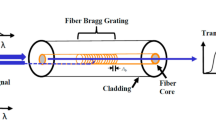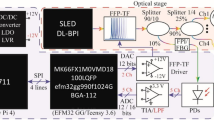Abstract—
Optical fiber sensor is attracting more attention in the structural health monitoring of civil applications. A general interrogator which can be used for both SOFO and fiber Bragg grating (FBG) sensors has been proposed, it has a lower cost with a much simpler design. Its accuracy can reach up to ~2.5 με, it has a niche market where it can compete with the conventional sensors.
Similar content being viewed by others
Avoid common mistakes on your manuscript.
1 INTRODUCTION
Structural health monitoring (SHM) system is to measure and monitor the health of the structure aiming at the evaluation of structural status and damage. Strain is the most important parameter to assess the structural health. A SHM system is composed of multiple sensors which can measure the parameters at each location. Conventional mechanical/electrical sensors is being used and they can measure most of these parameters. However, usage of optical fiber sensors (OFS) has been increasing greatly in the recent years as sensors for strain and temperature in the SHM applications worldwide [1–3]. Compared to other sensing systems, OFS possess specific advantages: higher accuracy and sensitivity, compact sizes, light weight, immunity to electromagnetic interference noise, safe for usage, resistance to environmental and chemical corrosion, and distributed sensing over long distances [4–6].
Long-gauge interferometric SOFO sensor is one of the OFS that has been widely used in monitoring structural health of building, dam, bridge, tunnel and pipeline, etc. [7–9]. SOFO sensors offer better performance in accuracy and temperature compensation than other kind of OFS, SOFO sensor also owns the merits of cost effectiveness, stability and scalability. Smartec’s SOFO sensor interrogator [10] has an strain accuracy of ~2 με, with measurement time of ~1 s, but its cost was more than one hundred thousands US dollars, which was too expensive for many users. In this paper, we proposed and built a lost cost SOFO sensor interrogator.
2 PRINCIPLE AND DESIGN
A SOFO sensor is actually an optical fiber displacement sensor, which has a higher resolution and a better stability, its internal structure is illustrated in Fig. 1. It was first proposed by Swiss Federal Institute of Technology in Lausanne, later it was commercialized by SMARTEC [10]. SOFO sensor is either surface-mounted on or embedded into the structure. The low coherence laser from a broad light source (such as SLED) is launched and split into two single−mode fiber (SMF) through a 50/50 coupler, the two SMFs are installed inside the SOFO sensor package pipe. The 1st SMF is under tension and hard clamped with the structure and environment, thus energy from external deformations and vibration will pass to it quickly, elongating or shortening it. The 2nd SMF is loosely installed inside the same package pipe is regarded as the reference fiber since it is without any deformation. There is one mirror at the ends of each fibers, they will reflect and recombine the lights which leads to interference.
The conventional SOFO sensor interrogators usually have higher costs which severely restrict its applications. Here we propose a novel interrogator design, through analysis of the reflected optical spectrum by the SOFO sensor, and applying our algorithms, we can measure both SOFO and FBG sensors accurately. This design is promising and full of potential because it combines the demodulation function of multiple types of OFS, such as both the SOFO sensor and FBG sensor. Such interrogator is particularly useful for applications where multiple types of sensor are deployed and spread out over a large distance. Our interrogator also owns the merit of low cost.
3 ALGORITHM AND DESIGN
Usually, the principle of the conventional static SOFO interrogator is based on the low-coherence interferometry in a single-mode-fiber. In the conventional SOFO interrogator [10], as shown in Fig. 2, a low-coherence scheme with wideband LED source and Mach−Zehnder (M−Z) interference is used along with a movable mirror or a tunable delay line to tune the optical path. In order to differentiate the pulse with a small separation of several picoseconds in the time domain, high speed photodetector is necessary here. Based on the Coherence length formula ΔL = λ2/Δλ, at 1550 nm wavelength and 100 nm spectral bandwidth, coherence length will be around 24 µm which determines the spacious resolution. Fiber stretcher is used to replace the tunable delay line in order to increase the scanning rate, but the cost is to sacrifice the maximum strain range. In the traditional design, optical path in two arms should match well, and polarization issue is also another important concern.
Our design is a general interrogator suitable for both SOFO and FBG, it works well in Frequency Domain and Scans reflective spectrum, as shown in Fig. 3. An optical switch is for the purpose of time multiplexing to decode more sensors. For the FBG sensor, it can find the peak FBG wavelength through peak tracing algorithms [4, 5]. But for SOFO sensor mode, there is typically an interference pattern across the full scanning spectral window, thus we need to use the following new algorithm.
For the SOFO fiber sensor, the interference condition is:
where q is an integral number (1, 2, 3, ….); L is the length difference of two fiber interference arms in SOFO sensor; \({{\lambda }}\) is wavelength which is around 1550 nm; n = 1.45 is refractive index of normal fiber.
Then the interference frequencies (1st order and high order harmonic frequency) are:
where \(C\) is the speed of light in a vacuum.
There are many discrete interference frequencies, and the free spectral range (FSR), which means the frequency gap between two neighbor peaks, is:
Typically, in a SOFO sensor, the initial fiber length difference is ΔL = 2 cm with a FSR—of 0.125 nm. Assume SLED spectral range ~1500−1600 nm with 100 nm bandwidth, there will have 800 periods which can be deduced quickly through using fast Fourier transform (FFT) on the scanning spectral amplitude. There are three available options on the market for the spectral detection module: (1) a diffractive grating module for optical spectral scanning; (2) optical channel monitor detection module; (3) tunable laser plus detector module for FBG operation. It doesn’t matter which model to choose, as long as it provides enough spectral resolution with low cost. In our experiment, we used Finisar’s high resolution channel monitor with a spectral resolution of 300 MHz, and Arcadia Optronix’s FBG demodulation module which has a spectral resolution of 2 GHz. Compared to traditional designs, our novel design has a much simpler structure and a much lower cost which is only about one tens of the Smartec’s cost. The measurement time of our interrogator is also about 1 s.
4 ERROR ANALYSIS AND EXPERIMENTAL RESULTS
The derivative of the above FSR equation is:
We used FFT to find the period in order to get the FSR, and then further went to find the deformation and displacement. If L is around 0.66 mm, and assuming that the frequency test error is about 10 pm in wavelength which is about 125 MHz in frequency, which will lead to a maximum displacement test error of about: ~0.005 mm from Eq. (4). Our SOFO sensor gauge length is 2 m (distance between two clamping/fixing places), then it is equivalent to a maximum strain error of 0.005 mm/2 m ≈ 2.5 με. It will need further averaging and curve fitting in order to achieve the higher accuracy.
We put the SOFO sensor on a customized sensor platform which can tune the displacement and strain continuously. Figure 4 shows our test results reading from the interrogator vs actual displacement reading with Vernier Caliper, the deformation is linear with the reading in its operating range. The fitting curve’s calculated gradient of 0.989 is very close to 1 shows the result is accurate, while the mean square deviation R2 = 0.9996 show almost perfect value. There was an initial displacement offset value of 38.9 mm.
5 CONCLUSIONS
The structural health monitoring is very important for a modern civil infrastructure. SOFO sensor is one of the most important and popular candidates amongst the applications to give an accurate and reliable sensing data. We have designed one low cost interrogator with a much simpler design, it scans the spectrum and use FFT to acquire the FSR and acquire the strain accordingly. Estimated accuracy can reach up to ~2.5 με, with measurement time of 1 s. In this niche market, its performance is comparable with Smartec but with only one tens of cost, furthermore it can also be used for FBG sensors.
REFERENCES
Cong Du, Susom Dutta, Pradeep Kurup, Tzuyang Yu, and Xingwei Wang, Sens. Actuators, A, 2020, vol. 303, no. 3, p. 111728. https://doi.org/10.1016/j.sna.2019.111728
Tosi, D., Sensors, 2015, vol. 15, no. 11, p. 27470, https://doi.org/10.3390/s151127470
Inaudi, D., Proc. 1st FIG Int. Symposium on Engineering Surveys for Construction Works and Structural Engineering, Session 6 - Fibre Optic Workshop, Nottingham, June 28−July 1, 2004.
Rodrigues, C., Inaudi, D., and Glišić, B., Int. J. Lifecycle Perform. Eng., 2013, vol. 1, no. 3, p. 209. https://doi.org/10.1504/IJLCPE.2013.058196
Tosi, D., Sensors, 2017, vol. 17, no. 10, p. 2368. https://doi.org/10.3390/s17102368
Leung, C.K.Y., Wan, K.T., Inaudi, D., Inaudi, D., Xiaoyi Bao, Habel, W., Zhi Zhou, Jinping Ou, Masoud Ghandehari, Hwai Chung Wu, and Imai, M., Mater. Struct., 2015, vol. 48, p. 871. https://doi.org/10.1617/s11527-013-0201-7
Cheng, W.C. and Ni, J.C., Tunnelling Underground Space Technol., 2009, vol. 24, no. 3, p. 331. https://doi.org/10.1016/j.tust.2008.08.005
Porco, F., Fiore, A., Porco, G., and Uva, G., J. Civ. Struct. Health Monit., 2013, no. 3, p. 3. https://doi.org/10.1007/s13349-012-0029-9
Mikami, T. and Nishizawa, T., Int. J. High-Rise Build., 2015, vol. 4, no. 1, p. 27. https://doi.org/10.21022/IJHRB.2015.4.1.027
https://smartec.ch/en/.
ACKNOWLEDGMENTS
The work was supported by the Key Research Incubation funding of Beijing Information Science and Technology University with no. of 2121YJPY209.
Author information
Authors and Affiliations
Corresponding author
Rights and permissions
Open Access. This article is licensed under a Creative Commons Attribution 4.0 International License, which permits use, sharing, adaptation, distribution and reproduction in any medium or format, as long as you give appropriate credit to the original author(s) and the source, provide a link to the Creative Commons license, and indicate if changes were made. The images or other third party material in this article are included in the article’s Creative Commons license, unless indicated otherwise in a credit line to the material. If material is not included in the article's Creative Commons license and your intended use is not permitted by statutory regulation or exceeds the permitted use, you will need to obtain permission directly from the copyright holder. To view a copy of this license, visit http://creativecommons.org/licenses/by/4.0/.
About this article
Cite this article
Gong, Y., Li, K. & Zhang, Z. Investigation on Low Cost Optical Fiber Sensor Interrogator. Instrum Exp Tech 64, 765–767 (2021). https://doi.org/10.1134/S002044122106004X
Received:
Revised:
Accepted:
Published:
Issue Date:
DOI: https://doi.org/10.1134/S002044122106004X








